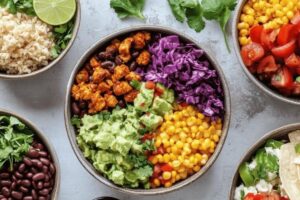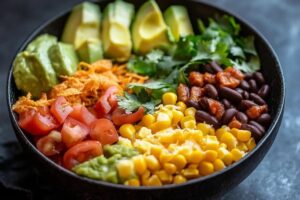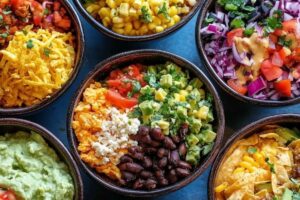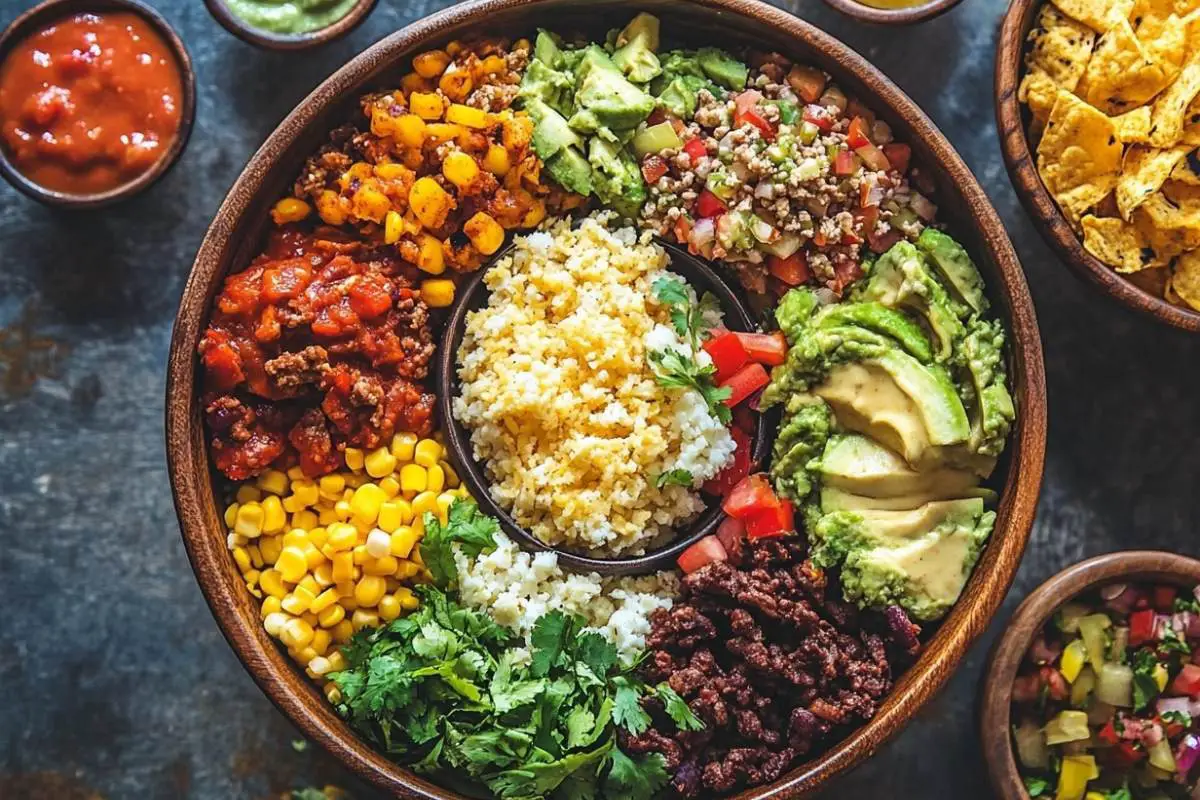Taco bowls are a versatile, delicious way to enjoy all the flavors of tacos without the mess of a tortilla. Whether you’re opting for a homemade crispy bowl, using lettuce as a base, or simply creating a satisfying mix of grains, veggies, and protein, taco bowls can be customized for any dietary preference. In this article, we will explore the main ingredients that go into making taco bowls, how to prepare them, and popular variations that will inspire your next meal.
What Exactly Is a Taco Bowl?
A taco bowl is essentially a deconstructed taco served in a bowl. Instead of using a soft or crispy taco shell, all the ingredients—like meat, vegetables, grains, and sauces—are layered in a bowl for easy eating. These bowls are a favorite for their ease, customization, and ability to hold a wide variety of fresh and cooked ingredients. You can enjoy taco bowls with a wide range of bases, including:
- Rice (common varieties include white, brown, or cilantro lime rice).
- Greens (romaine, arugula, or mixed greens as a low-carb alternative).
- Beans (black beans or pinto beans for extra protein).
The Key Components of a Taco Bowl
Taco bowls are as diverse as you want them to be, but they often contain the following key ingredients:
1. Protein Options
The base protein is where the bowl gets much of its flavor. Some popular options include:
- Ground beef: Typically, the most common choice for taco bowls, often cooked with taco seasoning for that signature flavor.
- Chicken: A lighter, leaner alternative, either grilled or shredded.
- Carnitas: Slow-cooked pork that adds a savory, rich flavor to the bowl.
- Shrimp: Perfect for seafood lovers, grilled shrimp adds a unique twist.
- Vegetarian options: Black beans, chickpeas, or tofu work well for those looking for a plant-based protein.
For an even richer flavor, you can use a homemade taco seasoning or add some salsa to the protein while cooking. Learn more about cilantro lime rice as a perfect base by checking out this recipe.
2. Base Options
The base of your taco bowl helps give it substance and texture. Common base ingredients include:
- Rice: One of the most popular base options, often seasoned with lime and cilantro. White rice, brown rice, or even cauliflower rice are great options.
- Lettuce: For a low-carb alternative, many people use romaine lettuce, spinach, or a mix of salad greens.
- Beans: Black beans and pinto beans are excellent sources of plant-based protein and fiber, often paired with rice or lettuce.
3. Toppings
Toppings allow you to get creative and customize your bowl. Some essential toppings include:
- Cheese: Shredded cheddar, Monterey jack, or Mexican blend cheeses.
- Guacamole: Fresh vocado or guacamole adds creaminess and a burst of healthya fats.
- Sour cream: A dollop of sour cream or Greek yogurt for a lighter option.
- Salsa or Pico de Gallo: Add a zesty punch with either a store-bought salsa or fresh pico de gallo.
- Jalapenos: Fresh or pickled jalapenos can add heat to your bowl.
- Fresh herbs: Cilantro is a popular choice for topping taco bowls, adding a bright, fresh flavor.
How Are Taco Bowls Made?

Making taco bowls is incredibly simple and can be tailored to any skill level. Here’s a basic guide to assembling the perfect bowl.
Step 1: Choose Your Protein
Start by cooking your chosen protein. For example, if you’re using ground beef, cook it in a skillet with taco seasoning and a little bit of olive oil until it’s fully browned. If you prefer chicken, grilling or slow-cooking are great options to retain moisture.
If you’re making a vegetarian taco bowl, you can heat black beans with a little seasoning and olive oil for flavor. For seafood lovers, grilled shrimp is an excellent protein option.
Step 2: Prepare Your Base
The base of the taco bowl can either be rice or lettuce. For rice, many people love to prepare a cilantro lime version. It’s simple to make by adding cooked rice, fresh cilantro, lime juice, and a pinch of salt.
For a lower-carb version, you can skip the rice entirely and use a bed of greens instead. Romaine lettuce or spinach works great for this.
Step 3: Add Vegetables
Incorporate both fresh and cooked veggies into your bowl for texture and nutrients. Some great choices are:
- Corn: You can grill or sauté corn for a sweet, smoky flavor.
- Bell peppers: Sautéed peppers add a nice crunch and sweetness.
- Onions: Sauté or caramelize onions for depth of flavor.
For an exciting twist, consider adding a popular Mexican side dish like grilled street corn to your taco bowl.
Step 4: Top It Off
Once you’ve layered your base and protein, it’s time to add the toppings. Mix and match according to your preferences. Popular choices include:
- Shredded cheese for creaminess.
- Sour cream or Greek yogurt for a tangy touch.
- Salsa or pico de gallo to add freshness and acidity.
- Guacamole for that rich, creamy texture.
- Jalapenos for spice.
How to Make Taco Bowl Shells
If you want to add a crispy taco bowl shell to your dish, it’s easy to do at home. Taco bowl shells are typically made from large tortillas, either baked or fried until crispy. Here’s how you can make them:
Ingredients:
- Large flour tortillas (10-12 inches)
- Oil for frying or baking
Method:
- Preheat the oven to 350°F (175°C).
- Lightly coat a tortilla with oil on both sides.
- Place the tortilla over an upside-down oven-safe bowl. Bake for 10-12 minutes or until golden and crispy.
- Let it cool and serve as a crispy base for your taco ingredients.
Alternatively, you can fry the tortilla in oil until golden brown and shape it into a bowl while hot.
Nutritional Value of Taco Bowls
Taco bowls offer a delicious and customizable way to enjoy a nutritious meal, but their nutritional value can vary significantly depending on the ingredients used. They are versatile enough to fit into a wide range of diets, from high-protein and low-carb to plant-based or keto. Here’s a breakdown of the nutritional aspects you can expect from different components of taco bowls.
1. Protein Content
The primary source of protein in taco bowls often comes from ingredients like ground beef, chicken, shrimp, or beans. Here’s a comparison of protein sources and their nutritional value:
- Ground Beef (85% lean): A 3-ounce serving provides around 240 calories, 20 grams of protein, and 18 grams of fat. Ground beef is rich in iron and B vitamins but also contains saturated fat.
- Chicken (grilled or shredded): A leaner alternative, grilled chicken breast offers approximately 165 calories, 31 grams of protein, and 3.6 grams of fat per 3-ounce serving. It’s a great option for reducing calories while maintaining protein.
- Shrimp: Grilled shrimp provides about 101 calories, 20 grams of protein, and 1 gram of fat per 3-ounce serving. It’s low in calories and fat but packed with protein and essential omega-3 fatty acids.
- Black Beans (1/2 cup): Beans are an excellent plant-based protein source, providing around 114 calories, 7.5 grams of protein, and 20 grams of carbohydrates. They also offer fiber, iron, and antioxidants.
2. Carbohydrates
Taco bowls usually contain a carbohydrate source, especially if you use rice or beans as part of the base. Here’s how the carbs stack up:
- White Rice (1 cup cooked): Around 200 calories, 45 grams of carbohydrates, and 4 grams of protein. Rice is a staple in taco bowls and can be flavored with cilantro and lime for extra taste.
- Brown Rice (1 cup cooked): Provides around 215 calories, 45 grams of carbs, and 5 grams of protein. Brown rice has more fiber than white rice, making it a more nutritious choice.
- Cauliflower Rice (1 cup cooked): A popular low-carb alternative, cauliflower rice has only 25 calories, 5 grams of carbohydrates, and 2 grams of protein. It’s a great option for those on a keto or low-carb diet.
- Tortilla Chips (1 ounce or about 10 chips): Around 140 calories, 19 grams of carbs, and 7 grams of fat. If used sparingly, they can add crunch to your taco bowl without significantly increasing calories.
3. Fats
The fats in taco bowls come from ingredients like cheese, avocados, sour cream, and oils. Fats can be beneficial when balanced with healthier options like avocados, but it’s important to keep portions in check if you’re watching your calorie intake.
- Avocado (1/2 medium): Offers about 120 calories and 11 grams of fat, most of which are heart-healthy monounsaturated fats. Avocados also provide fiber, potassium, and vitamins.
- Shredded Cheese (1/4 cup): Depending on the type, cheese provides around 110-120 calories, 9 grams of fat, and 7 grams of protein. It also contributes calcium and vitamin D.
- Sour Cream (2 tablespoons): Adds about 60 calories and 5 grams of fat. You can opt for reduced-fat sour cream or swap it for Greek yogurt, which offers fewer calories and more protein.
4. Fiber
A well-balanced taco bowl can be a great source of dietary fiber, especially if you include ingredients like beans, vegetables, and whole grains. Fiber is essential for healthy digestion and can help maintain satiety.
- Black Beans or Pinto Beans (1/2 cup): Beans are a high-fiber food, providing about 7-8 grams of fiber per serving. They also help lower cholesterol and regulate blood sugar.
- Vegetables: Adding fresh veggies like lettuce, tomatoes, and onions can increase the fiber content of your taco bowl. A cup of romaine lettuce has around 1 gram of fiber, while tomatoes and onions can add about 2 grams combined.
5. Vitamins and Minerals
Taco bowls are rich in essential vitamins and minerals, thanks to the variety of ingredients:
- Avocados provide vitamin C, vitamin K, and potassium.
- Beans are a great source of folate, iron, and magnesium.
- Tomatoes and other vegetables add vitamins A and C, which support immune function and skin health.
- Cheese and sour cream contribute calcium for bone health.
Healthier Modifications for Taco Bowls

To make your taco bowl even healthier, here are a few adjustments you can consider:
- Use leaner proteins like ground turkey or chicken instead of beef to reduce saturated fats and calories.
- Opt for Greek yogurt instead of sour cream for added protein and fewer calories.
- Incorporate more vegetables such as bell peppers, onions, or corn to increase fiber and vitamin content.
- Swap white rice for brown rice or quinoa to add more fiber and protein to your meal.
- Reduce cheese or use a lower-fat option if you’re trying to cut back on calories or fat.
Sample Nutritional Breakdown (Per Serving)
Here’s an example of the approximate nutritional value of a standard taco bowl with ground beef, cilantro lime rice, black beans, cheese, sour cream, and avocado:
- Calories: 600-750
- Protein: 30-35 grams
- Carbohydrates: 55-65 grams
- Fat: 30-35 grams
- Fiber: 10-12 grams
This meal provides a good balance of macronutrients, but you can adjust portion sizes and ingredients to suit your nutritional goals.
Final Thoughts on Taco Bowl Nutrition
Taco bowls can be as nutritious or indulgent as you make them. The beauty of this dish lies in its flexibility, allowing you to tailor the ingredients to meet your dietary needs. By choosing lean proteins, incorporating healthy fats, and bulking up with fiber-rich vegetables, you can create a taco bowl that not only satisfies your taste buds but also supports your health goals.
Popular Variations of Taco Bowls
While the classic taco bowl is always a favorite, there are many ways to get creative with your recipe. Here are a few popular variations:
1. Vegetarian Taco Bowl
A vegetarian taco bowl is an excellent option for those looking for a plant-based meal. Instead of meat, use:
- Black beans, pinto beans, or a mix of grilled vegetables.
- Top with guacamole, salsa, and shredded cheese for a flavorful dish.
2. Low-Carb Taco Bowl
For those following a low-carb diet, swap out the rice for a bed of romaine lettuce or spinach. You can still enjoy the same great flavors with fewer carbohydrates by using extra vegetables or cauliflower rice instead.
3. Seafood Taco Bowl
Grilled shrimp or fish can give your taco bowl a coastal twist. Try seasoning shrimp with lime juice, garlic, and a touch of cayenne for a zesty addition.
4. Sweet Potato Taco Bowl
For a hearty and unique twist, consider adding roasted sweet potatoes as a base or topping. The sweetness pairs beautifully with the smoky, savory flavors of traditional taco ingredients.

Conclusion
Taco bowls are a customizable and versatile dish that can cater to any dietary preference. Whether you’re looking to indulge in a flavorful, crispy bowl or aiming for a healthier option with a lettuce base, there’s a taco bowl recipe for everyone. Try different combinations of proteins, bases, and toppings to create a meal that’s satisfying, delicious, and full of nutrients. Whether you prefer beef, chicken, or vegetarian options, taco bowls offer endless possibilities for creativity in the kitchen.

